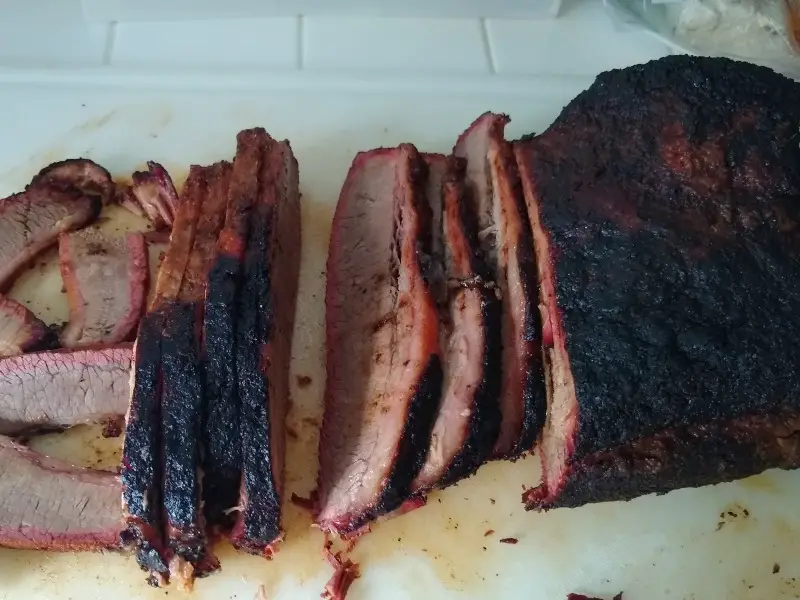
Beef brisket is one of the most popular meats to smoke, and for good reason. When done correctly, it can be incredibly tender and juicy, with a deep, rich flavor that is unparalleled in the world of barbeque.
However, beef brisket is also one of the toughest cuts of meat, and it can be very difficult to get right. If you’re looking to make the best beef brisket around, cooking it on a pellet smoker is the way to go, AKA a pellet grill.
Pellet smokers are able to maintain a consistent temperature over long times, meaning that the meat will cook evenly and won’t require as much attention. In addition, pellet grills infuse the meat with flavor as it cooks, adding another layer of deliciousness to the dish. For these facts, a pellet smoker can be perfect for a brisket.
Also, pellet smokers are very easy to use, making them perfect for the occasional smoker cook or beginner cook. So if you’re ready to learn how to cook beef brisket on a pellet smoker, read on for some tips and tricks.
Note: most links in this article are Amazon.com Affiliate links, see Affiliate Disclosure, thank you.
Equipment to Getting Started
When it comes to smoking meat, preparation is key. Before you even start the prepping and smoking process, you need to make sure that everything is ready to go. The last thing you want is to run into any problems, like needing an ingredient or wood in the middle of the process, which can lead to a bad end product.
To avoid this, it’s essential to make a checklist of all the equipment you need to get started. This way, you can be sure that you have everything you need on hand before you start smoking your meat. By taking these necessary precautions, you can ensure that your smoked meat turns out perfectly every time.
- Pellet smoker
- Pellets
- Aluminum foil
- Large tongs
- Spray bottle
- Thermometer
- Sheet pan
- Bucket of water and fire extinguisher
This will be some essential equipment you need to get started with the smoker. In addition to a thermometer to check the temperature of the meat, you will also need a thermometer to ensure the smoker is at the temperature the control panel is displaying.
Keeping a bucket of water close by is always a best practice when using any type of smoker. However, for grease fires, you need a fire extinguisher or, at minimum, a large box of baking soda close by.
When choosing wood pellets for smoking, it is important to select a type that will complement the bold flavor of brisket. Woods like hickory and mesquite will provide a strong, rich flavor that pairs well with the beef.
If you want to experiment with other flavors, you can mix different types of pellets, such as fruitwoods or nut woods. Apple, cherry, and pecan all work well with beef brisket and can add an interesting dimension to the flavor profile.
Do you have an electric smoker?
Check out our article How to Smoke a Brisket in a Masterbuilt Smoker.
Buying a Brisket
When you choose the brisket from the store, if the whole brisket is available, you want to spring for that. Our favorite size of brisket is in the 13-pound range because it is easy to handle and can be cooked low-n-slow for around 12 hours plus an hour of rest time. A perfect balance of time and temperature can result in the best flavor, so size is important.
Some stores will only sell brisket in pieces, the flat or the point. If possible, you want to avoid buying pieces. When you go to a store or butcher shop, ask for a packer brisket, and they will point you to the best type of brisket for smoking.
Preparation
Trimming You Brisket
If you’re lucky enough to find a pre-trimmed brisket, then you can skip straight to the cooking process. However, if you do end up with an untrimmed brisket, there are a few things you’ll need to do before you start cooking.
First, remove the hard fat cap from the top of the brisket. This will help the meat cook evenly, and this fat layer is not good to eat. Trim the soft fat to 1/4 inch thickness. It will render down and add great flavor when sliced.
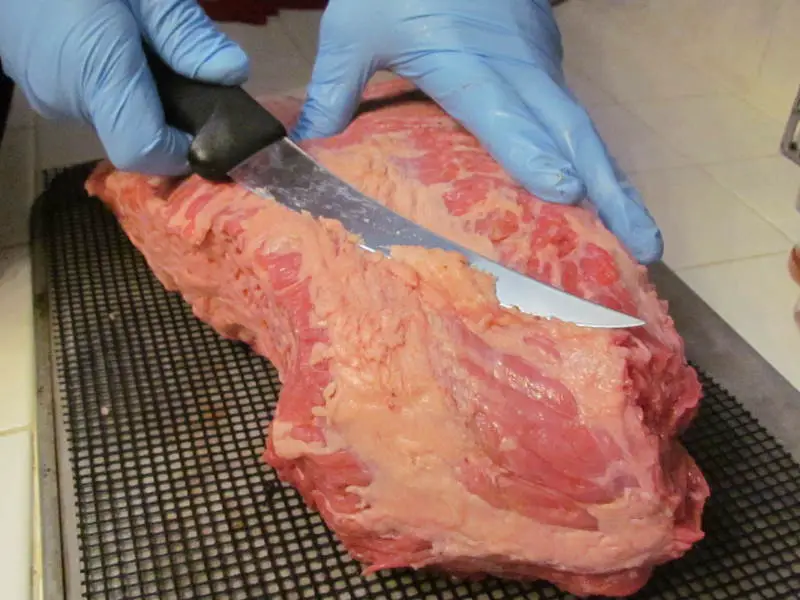
Removing pieces of silver skin will make for a better eating experience and allow for better smoke penetration. Lift the edge with a round boning knife and pull with a paper towel. If the silver skin doesn’t release, use the knife to gently slice under it and remove as much as possible.
Next, use a sharp knife to trim any sharp edges and cut off the corners. Some people say that rounding the edges helps with airflow, but in our opinion, it prevents dry or burnt edges.
Finally, save the leftover brisket scraps – they’re great in chili or beef stew!
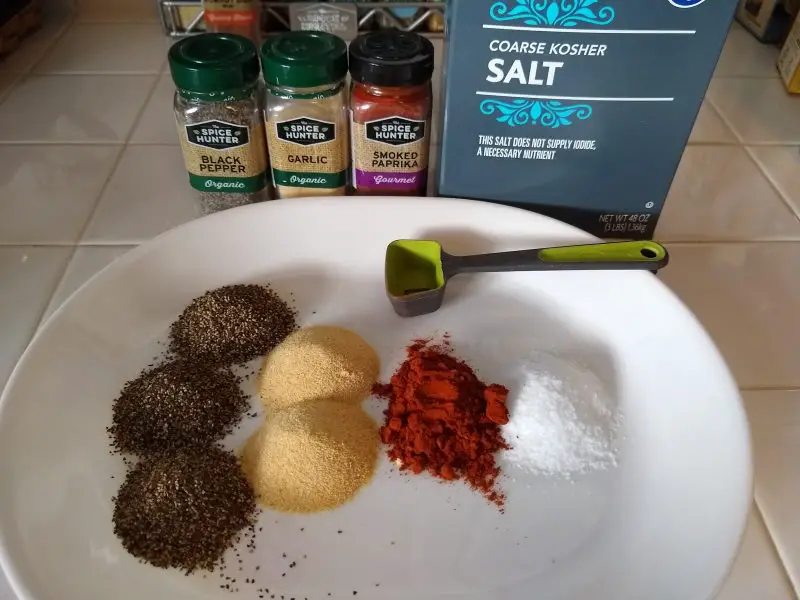
Seasoning Your Brisket
When it comes to seasoning beef brisket, everyone has their favorite brisket recipe, but dry rubs are usually the best way to go. Wet rubs or marinades are better for hot cooking methods like grilling, but a dry rub will complement the brisket nicely. Remember not to apply the rub more than 15 minutes in advance if it contains salt, as this will draw out the brisket’s natural moisture and result in a dry finished product.
When it comes to creating a dry rub, there is no need to get too fancy – salt and black pepper usually suffice. However, you can always add a little extra something to give the beef brisket an extra punch. Experiment with different spices and seasonings until you find a combination that you like best.
- ¼ cup kosher salt
- ¼ cup coarse ground black pepper
- 5 tbsp. Garlic Granules
- 3 tbsp. Onion powder
- 2 tbsp. smoked paprika

For great results consider our top pick, Spicehunter has rack packs and individuals. Click on these links to see on Amazon.com.
Depending on the size of your brisket, you may need to adjust the recipe accordingly. To begin, place the trimmed brisket on a large sheet pan and lightly coat the sides. Then, use a generous amount of seasoning to cover the top and bottom surfaces of the brisket.
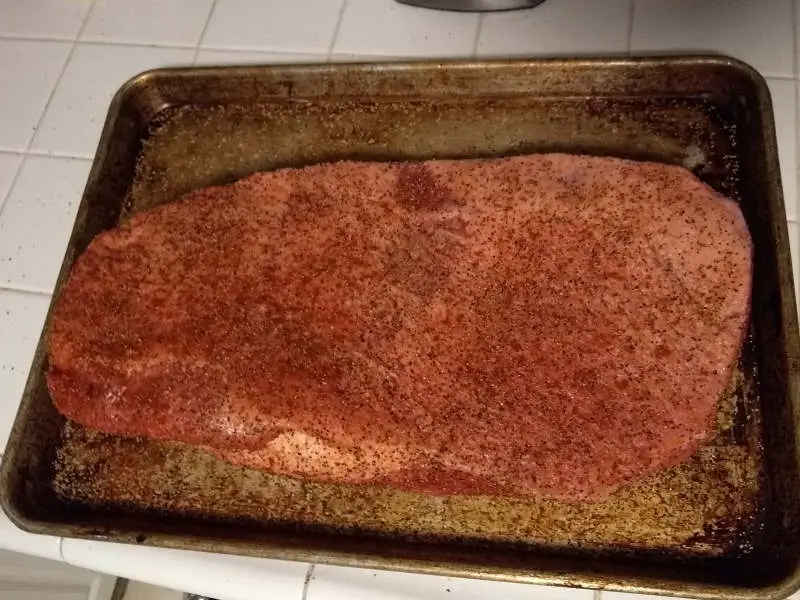
Be sure to get into all the cracks and crevasses so that the meat is evenly seasoned. Once you have seasoned the brisket, you can leave it on the sheet pan until you are ready to smoker.
After placing the brisket in the smoker, apply a touch of the seasoning mixture to any areas that may have lost seasoning during handling. By following these steps, you can ensure that your brisket is properly seasoned and ready for smoking.
Note: garlic powder performs differently than garlic granules, so unless you have no choice, stick to what your brisket recipe calls for to get the best results.
Check out our Smoked Brisket FAQ article
The Smoking Process
Getting started
My pellet smoker setup includes a quick cleanup with a shop vac to clear the burn pot of all ashes. The simple step of cleaning your pellet grill can improve your performance on every cook.
Fill your pellet hopper completely when before you start a long cook. I like running the pellets out completely because high humidity can cause the pellets to turn to dust and then harden up in the auger. As you come to the end of your cook, you can if the pellet hopper with enough pellets to run just past your cook time.
Then I like to preheat the pellet smoker on a low setting of 180 degrees or the smoke setting for at least 15 minutes.
Start Cooking
When you are ready to start cooking, raise the temperature to 225 degrees. Place the seasoned brisket in the smoker, fat side up. Close the smoker and begin the smoke.
You will want to smoke the brisket for around 8 hours to start or to 160 degrees internal temperature. Keep in mind this is a temperature process, not a time process. The times in the article is an estimate for a typical 13-pound whole brisket, pre-trimmed.
During the smoking process, you can keep checking the meat’s internal temperature if you like, but we tend to wait until further along because leave-in probes get in the way if you wish to rotate or flip your brisket.
You can use a spray bottle and give the beef brisket a spritz every once in a while if you like a moister surface. You can fill your spray bottle with any marinade you like.
Most people use water with a little apple juice or beer. Make sure to maintain the pellet grill at a temperature of 225 degrees during the first smoking process and keep the hopper full of pellets.
Some people choose to flip their beef brisket at the 6-hour mark to prevent liquid from pooling on the top and promote an even crispy crust.
Second Stage of Cooking
After 8 hours, remove the beef brisket from the pellet smoker and wrap it in aluminum foil completely. Some people like to use pink butcher paper if it is available to them. Using butcher paper will seal the juices in while allowing the smoky flavor to continue to penetrate the meat.
Aluminum foil will be just fine to use as long as the beef brisket is completely covered and wrapped tightly, leaving no moisture room to escape. Place the wrapped brisket back in the pellet grill and raise the temperature to 275 degrees for roughly another 4 hours.
If you have a probe thermometer, place it in the beef brisket at this time so you can monitor the internal temperature of the smoked brisket. If not, you will have to open the smoker every so often to check the brisket’s internal temperature.
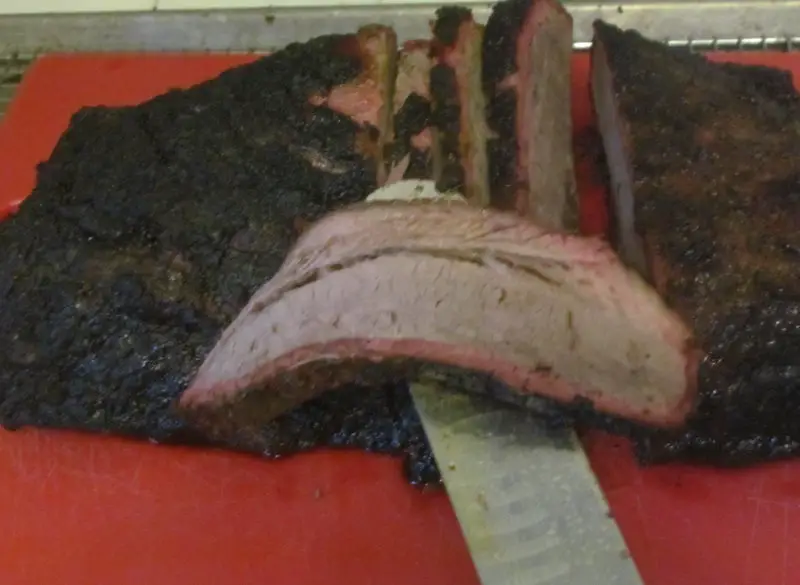
Knowing When Your Brisket is Done
Continue to smoke the beef brisket until the internal temperature of the brisket point reaches 195 degrees. Once finished, remove from the smoker and rest for 60 minutes, wrapped in foil or paper in a dry cooler or unused oven. During the resting time, the smoked brisket will continue to “carry over cooking,” but mostly, the temperature will balance, allowing the juices to evenly spread throughout the meat.
If you like a softer brisket, consider cooking until your internal temperature reaches 205 degrees. But be careful; you can overcook your smoked brisket. If the foil is not well sealed, your brisket can dry out, or well-sealed foil can trap all the moisture, and your brisket can become mushy. Typically, you will need to add 45 minutes to your cook time for ten more degrees, but it can vary.
When ready to serve, unwrap the smoked brisket, place it on a cutting board, and slice it against the grain. If you do not cut against the grain, the meat will become somewhat stringy and, in some cases, hard to chew. Check out the tip below.
Summary of Steps
- Preheat the smoker to 185 degrees
- Trim your brisket
- Season your brisket
- Cook your brisket at 225 for 8 hours
- Wrap your brisket
- Cook your brisket at 275 for another 4 hours
- Rest your cooked smoked brisket for 1 hour
- Slice your cooked smoked brisket across the grain and enjoy
Tips and Tricks for Smoked Brisket
- Most people use aluminum foil to wrap their beef brisket in for the cooking process’s last leg. But you can use pink butcher paper instead of aluminum foil if you prefer. Sometimes the aluminum foil can overcook the brisket and give a metallic taste to the already-finished bark surface.
- There are two sections to the brisket, the point and the flat. The flat section is cut across the section into strips. The Point section is thicker, and the grain runs across the section, so it will need to be cut lengthwise. Some barbeque restaurants like to take the point.
- When placing your brisket on your smoker, always place the point end toward the hottest area of your smoker. The flat end tends to dry out faster in higher heat.
- It is best to allow your brisket to rest for at least 30 minutes at room temperature, wrapped in butcher paper or aluminum foil to slow down the cooking process and will enable the meat to retain all of its juices, so it doesn’t dry out once you start to slice it up.
- When resting your brisket, a dry, empty cooler make an excellent place for your rest, and if you plan for a long rest, you can place it in a 175-degree oven.
- If you have a favorite bbq sauce, you can add it during the last hour to get a yummy glaze effect. Also, mixing bbq sauce with low-sodium beef broth marked a great basting liquid or an injecting liquid.
Do you have leftover brisket? Check out our 7 Incredible Brisket Recipes.
Conclusion
Brisket can be a challenging meat to cook, but following basic steps can get help you get great results. Then add the right tips and tricks, and you can create a masterpiece that your friends and family will love.
Follow our guide above for the best results, and remember to always slice against the grain to ensure tender, juicy bites.
Click here to see some of our Best Pellet Smokers picks
FAQ
What temperature should beef brisket be smoked at to reach the fall-apart status?
Most smokers will need to run between 265 and 275 degrees for 10 to 12 hours. Brisket should be cooked to an internal temperature of 205 degrees to be properly smoked.
Can the process of smoking brisket be fast-cooked?
It is possible to cook a brisket faster, this is typically called the “hot-n-fast cook method.” A good temperature setting for your smoker would be 350 degrees. We recommend that you use a beef broth-based injection to keep your brisket moist. Wrapping your brisket when the internal temperature reaches 160 degrees is another way to trap moisture. The main downside of the “fast-n-hot cook method” is the connective tissue might not break down completely.
Can you overcook beef brisket?
Yes. Even though beef brisket takes a long time to cook, cooking it too long or at high temperatures could result in a very dry and tough end product like beef jerky. When wrapped, an overcooked brisket can fall apart, much like a pot roast.
For more FAQs about Brisket
